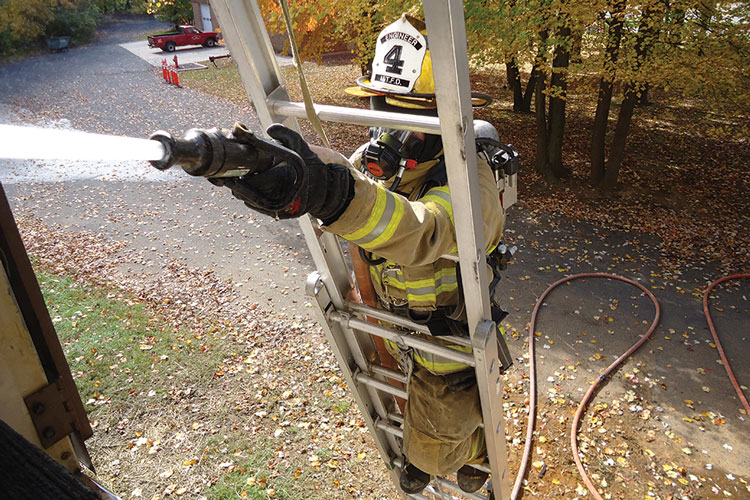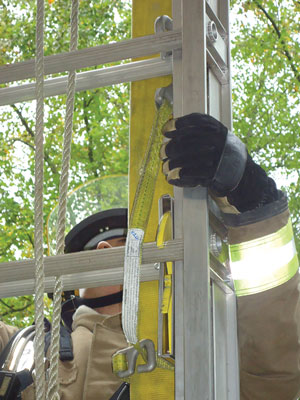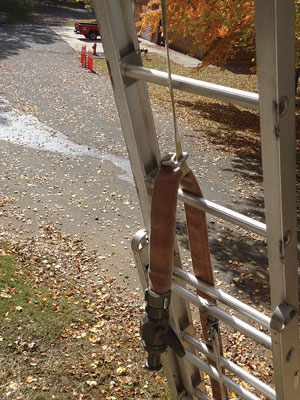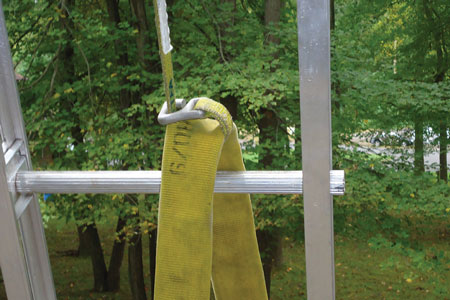
BY JACK HUESTON
At structural fires, occasionally you need to operate exterior fire streams into the building from elevated positions. Using an elevated master stream device from a tower ladder, an articulating boom, or other aerial device is the best and safest way to do this. When the terrain or road access prevents using an aerial device, the only other option is to operate a handheld hoseline from a portable ladder.
Operating handheld hoselines from portable ladders is a low-frequency/high-risk evolution. When you consider the combination of the charged hoseline’s weight, gravity, and the nozzle reaction forces, you realize that only properly equipped and skilled members should conduct the evolution. Unfortunately, most times when this evolution is conducted on the fireground, firefighters take shortcuts in the proper steps, which creates an unsafe situation that sometimes leads to injuries. This evolution is part of the National Fire Protection Association 1001, Standard for Firefighter Professional Qualifications (NFPA 1001, 2013 ed.), 5.3.10.B, but most members probably last practiced it during Firefighter I.
Equipment
The safest way to perform this evolution is with a 1¾-inch hose (no larger) and two hose straps (photo 1). The hose size limit takes into consideration its weight and the nozzle reaction force. A charged 50-foot section of 1¾-inch hose with a nozzle weighs approximately 70 pounds; a similar length of charged 2½-inch hose with a nozzle weighs 140 pounds.
 |
| (1) The hose is properly secured with two hose straps using the “in-and-out” method of rigging. The strap is lashed to the hose, then extended upward inside the ladder toward the building and then brought outside the ladder away from the building and hooked over the rung two rungs up. The firefighter is using a leg lock on the side opposite of the hoseline. (Photos by author.) |
Second, consider the nozzle reaction force. Most 1¾-hose and nozzle combinations have a nozzle reaction of less than 100 pounds of force. A nozzle reaction greater than 100 pounds force could destabilize the ladder.
 |
| (2) The nozzle hose strap controls the nozzle reaction force. The rear hand encircles the nozzle hose strap and hose, keeping the strap from accidentally slipping. The forward hand controls and directs the nozzle. |
The most important pieces of equipment in this evolution are the two hose straps. The nozzle hose strap controls the nozzle reaction force and is attached to the ladder approximately an arm’s length behind the nozzle (photo 2). The foot strap supports the charged hoseline’s weight and is attached to the ladder just below the rung on which the nozzle firefighter is standing (photo 3).
 |
| (3) The boot hose strap supports the weight of the hose, keeping it from pulling downward, and is also rigged using the “in-and-out” method. |
The method with which the hose strap is rigged to the ladder is extremely important, especially the nozzle hose strap. The method also depends on the type of hose strap. Commercially made hose straps are available, but a firefighter can also fabricate his own. A simple homemade hose strap consists of a 36-inch loop of one-inch tubular webbing tied with a water knot with a carabiner clip (photo 4). I used commercial hose straps for this article (photo 5).
 |
| (4) A 36-inch-long loop of one-inch tubular webbing serves as a hose strap. |
Hose Rigging and Operation
The following procedure describes the setup and operation of a charged hoseline from a portable ladder to be operated through an upper-floor window, with no fire venting through the window. Since “always” doesn’t exist in firefighting, you may have to modify these procedures depending on the conditions and where you need to apply water – through an attic vent or over a parapet. Whenever possible, using two hose straps will make the operation as safe as possible.
 |
| (5) A commercially manufactured strap at the boot position rigged with the “in-and-out” method. |
- Raise the appropriate length of portable ladder five to six rungs above the target window.
- The member ascends the ladder with the dry uncharged hoseline.
- Drape the nozzle over the rung closest to windowsill height; allow approximately an arm’s length of hose to lay over the rung (photo 6).
 |
| (6) The nozzle hose strap is rigged using the “in-and-out” method. |
- Snare the hose with a hitch about an arm’s length behind the nozzle, using the small hook end of the nozzle hose strap. The opening in the hook should face away from the nozzle; if using tubular webbing, girth hitch the hose (photo 7).
 |
| (7) When using a commercially manufactured hose strap, rig the opening in the small hook facing away from the nozzle and downward. |
- The large hook end of the nozzle hose strap is then extended upward first between the ladder and building and brought between the rungs to the outside of the ladder and hooked over the rung two rungs up in the “in-and-out method.” Rigging the hose and strap in this fashion is critical. When the nozzle is operated, the ladder rung will allow the reaction force to push the line back only four to five inches. Rigging the strap on the outside of the ladder would allow the reaction force to push the line the full length of the strap. This could push the nozzle firefighter off balance, causing him to fall, or the ladder to spin away from the building.
- When the nozzle hose strap is set, the member then climbs down to the level where the foot hose strap will be set. This is normally about five rungs down from the rung over which the hoseline nozzle end was draped. The foot hose strap is then rigged in a similar fashion.
- The member should then climb down from the ladder before the line is charged.
- When the line is charged, flake out extra hose on the ground in line with the ladder for about 10 feet.
- The nozzle firefighter should then climb the ladder, position himself with his shoulders at windowsill height, and use a leg lock or a ladder belt. One hand should be positioned on the hose over the hose strap with his hand and fingers encircling the strap and hose. Make sure that the strap is set before operating the nozzle. The other hand will control and direct the nozzle.
- The nozzle can be directed up or down but never more than 45° side to side. If the nozzle is operated more than 45° to either side, the ladder will become very unstable and could slide or roll off the wall.
- As in any portable ladder operation, a member should foot the ladder at all times as the other firefighter is climbing it. In this case, the backup firefighter will be the ladder foot. He must readjust the hose if a kink develops between the two straps and ensure that the foot strap stays tightly set. If the foot strap loosens, he should tell the nozzle firefighter to shut down until it is reset.
Operating hoselines from portable ladders is a low-frequency/high-risk evolution. To perform it safely, we must practice it often in company drills and have the proper equipment readily available, especially the two hose straps. The hose strap is one of the forgotten tools of the fire service. We don’t give it much thought until we need it. Sure, we could rig the hose with rope, but with two proper hose straps ready to go, the job is far more efficient, quicker, and safer. Every good engine company firefighter should have a hose strap in his coat pocket or at least know where to find one on the engine.
JACK HUESTON is a 30-year veteran of the Middletown Township (NJ) Fire Department and captain of its Special Service Unit. He is a New Jersey certified level 2 fire instructor with the Middletown Fire Academy and with the Monmouth County Fire Academy. Hueston is a retired police officer and served 26 years with the Middletown Police Department.
EXTERIOR HOSE STRETCHES, PART 1: SINGLE HANDLINE OPERATION
The Spanner Belt
Engine Company Options for an Initial Action Plan
Fire Engineering Archives

